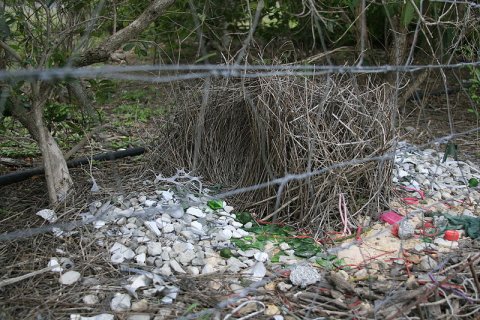
Bowerbirds are incredible. They have a complex courting ritual in which the male builds a bower (such as the one pictured above) in order to attract a mate. The bower is often quite elaborate, and it is usually decorated with all manner of objects, such as flowers, shells, stones, feathers, and small fruits. Male bowerbirds will even include human-made objects like bottlecaps, coins, and pieces of glass in their decor. Females that are interested in the bower will watch the male put on his courtship display in the “court” of his bower, and she will also inspect details of the bower to determine whether or not the male is worthy of her. If she mates with the male, she will not use the bower as a nest. Instead, she will build her own nest to hatch and raise her young. Thus, the only purpose of the bower is for the male to attract a mate.
If the picture above doesn’t impress you with regard to the male bowerbird’s artistic prowess, consider this: In 1872, naturalist Odoardo Beccari was the first to record observations of a bowerbird’s bower. He thought it was made by a person, because he considered it too artistic and elaborate to be the work of an animal.1 Not surprisingly, as biologists have studied bowerbirds in more detail, they have become even more impressed with the artistic prowess of this amazing animal.
John A. Endler, Lorna C. Endler, and Natalie R. Doerr recently studied the bower-making process of Great Bowerbirds (Chlamydera nuchalis).2 As had been noticed before, the male birds build their bowers in such a way as to force the female to view the court of the bower from only one angle. Look, for example, at the bower pictured above. To see the male, the female must look through the “tunnel” of sticks. The stone “floors” on either side of the tunnel serve as the male’s “court.” The tunnel, then, forces the female to look at the male from only one angle.
Analyzing the bower from this viewpoint, the biologists noticed something that others had missed. When building the bower, the male decorates with objects whose size increases with increasing distance from the tunnel. This produces an an aesthetically-appealing view of the court, but the investigators think it does something even more amazing. If the female birds see things essentially as a person sees things, this mode of decoration makes the male bowerbird appear larger while he is in his court. In other words, the male bowerbird constructs an optical illusion in order to impress his potential mate!
Of course, the question that immediately comes to mind is whether or not the male bird really understands this. In order to attempt to answer that question, the biologists decided to mess with the birds’ designs. Once the bower was built, the authors rearranged the objects used in the decor when the male was not present. They put the smaller things farther from the tunnel and the larger things closer to the tunnel. Within three days, the male birds noticed this and rearranged the objects so they once again increased in size the farther they were from the tunnel.
So not only do these amazing birds build impressive bowers to attract a mate, they essentially build a stage that forces the female to watch them from an angle that enhances their courtship display. God’s creation continues to amaze me!
REFERENCES
1. Jeffrey Moussaieff Masson, The Emperor’s Embrace: Fatherhood in Evolution, Vintage, 2000, p. 147.
Return to Text
2. John A. Endler, Lorna C. Endler, and Natalie R. Doerr, “Great Bowerbirds Create Theaters with Forced Perspective When Seen by Their Audience,” Current Biology, doi:10.1016/j.cub.2010.08.033, 2010 abstract available online
Return to Text

Wow. It seems slightly strange to me that a bird would have such similar vision, particularly 3D vision, to ours when it’s eyes are on the sides of its head. Still I don’t see any other reason to prefer that arrangement, so assuming that the bird is intentionally/instinctively creating an illusion seems like the best option. Pretty Incredible.
The thing that I think about is the bird’s needs when it comes to flying. I would think it would be very hard to navigate while flying unless you had 3D vision, especially given that flight is true 3D motion. So while many animals could get along fine without 3D vision, I would think a bird would need it.
Hi Dr. Jay!
I came across your blog a few weeks ago. Tonight I finally had time to comment and say how much fun it has been to read several of your posts. Your wonder of God’s creation is contagious. I have to admit, some (many) of your posts are beyond my sleep deprived brain, but it’s wonderful to be challenged into thinking about issues that aren’t covered in a third grade curriculum. 🙂
Bethany, it is so good to hear from you. Thanks for commenting!
My memory was that Raptors had bifocal 3D vision and depth perception, but they were unique among birds in that capacity. Still even with one eye (or a camera) things look smaller with increasing distance, and I suppose that’s what this illusion depends upon.
According to How Stuff Works:
So you are right in the sense that raptors use their 3-D vision the most, but it seems that all birds have it to some extent. I would think that even those that don’t use it a lot will still use it for navigating during flight.